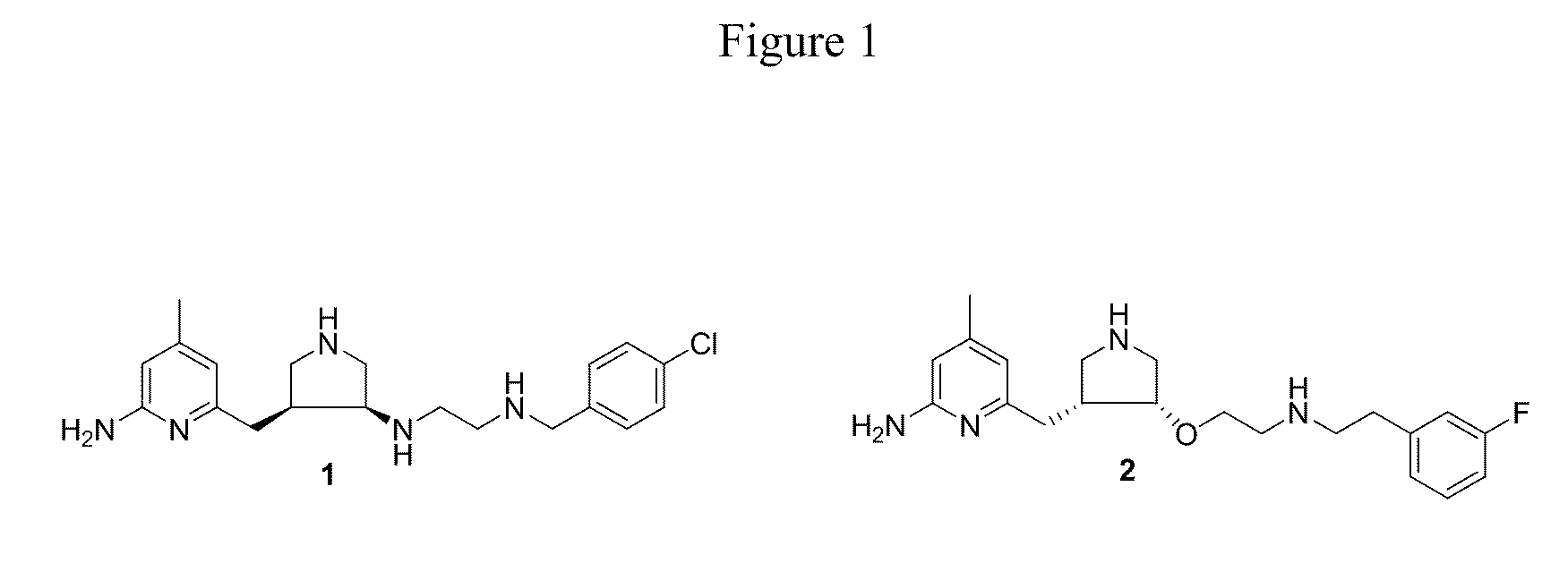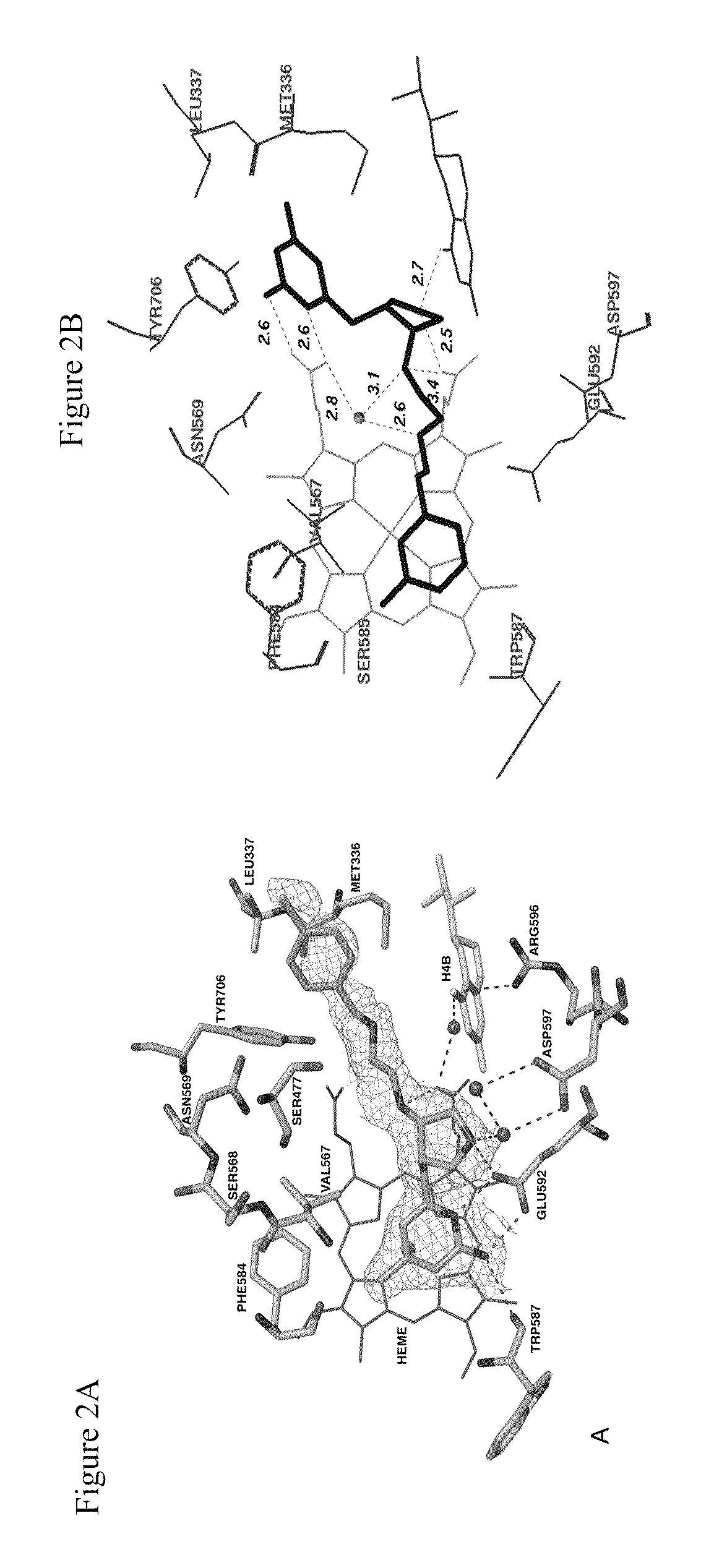Aminopyridine dimer compounds, compositions and related methods for neuronal nitric oxide synthase inhibition
a technology of nitric oxide synthase and dimer compounds, which is applied in the direction of chemical treatment enzyme inactivation, drug compositions, anti-noxious agents, etc., can solve the problems of complex syntheses of 1 and 2, impede the application of compounds as candidates for neurodegenerative diseases, and achieve the effect of increasing the bioavailability of such compounds and enhancing penetration through biomembranes
- Summary
- Abstract
- Description
- Claims
- Application Information
AI Technical Summary
Benefits of technology
Problems solved by technology
Method used
Image
Examples
example 1
[0049]General Method A: Synthesis of 2,5-dimethylpyrrole-protected inhibitors 6b-6m. To a solution of 7 (500 mg, 2 5 mmol) in THF (10 mL) at −78° C. was added n-BuLi (1.6 M solution in hexanes, 1.64 mL, 2.63 mmol) dropwise. The resulting dark red solution after the addition was transferred to an ice-bath. After 30 min, a solution of bis-bromide 5a, 5b, 5c, or 5d (1 M in THF) was added dropwise until the dark red color disappeared. (See, Momenteau, M.; Mispelter, J.; Loock, B.; Lhoste, J. M. J. Chem. Soc. Perkin Trans. 1 1985, 1, 61-70, incorporated herein by reference, for a general synthetic technique for bis-bromide preparation.) The reaction mixture was allowed to stir at 0° C. for an additional 10 min then quenched with H2O (20 μL). The solvent was removed by rotary evaporation, and the resulting yellow oil was purified by flash chromatography (EtOAc / hexanes) to yield 2,5-dimethylpyrrole-protected inhibitors 6b-6m.
example 2
[0050]General Method B: Synthesis of inhibitors 3a-3m. To a solution of 6a-6m (0.5 mmol) in EtOH (10 mL) was added hydroxylamine hydrochloride (NH2OH.HCl, 340 mg, 5 mmol) followed by H2O (5 mL) The reaction mixture was heated at 100° C. for 20 h. After cooling to room temperature, the reaction mixture was partitioned between Et2O (50 mL) and 2 N NaOH (25 mL) The aqueous layer was extracted with Et2O (2×25 mL), and the combined organic layers were dried over Na2SO4. The solvent was removed by rotary evaporation, and the resulting yellow oil was purified by flash chromatography (5-10% MeOH in CH2Cl2) to yield inhibitors 3a-3m.
example 3
[0051]
[0052]Di-tert-butyl naphthalene-2,6-diylbis(methylene)bis(4,6-dimethylpyridin-2-ylcarbamate) (6a). To a solution of 4 (444 mg, 2 mmol) in DMF (10 mL) at 0° C. was added NaH (60% in mineral oil, 88 mg, 2.2 mmol). After 15 min, bis-bromide 5a (314 mg, 1 mmol) was added slowly. The reaction mixture was allowed to stir at room temperature for 6 h then concentrated. The crude product was purified by flash column chromatography (EtOAc / hexanes, 1:9-1:4) to yield 6a (960 mg, 81%) as a white solid: 1H NMR (500 MHz, CDCl3) δ 1.41 (s, 18H), 2.29 (s, 6H), 2.45 (s, 6H), 5.33 (s, 4H), 6.72 (s, 2H), 7.28 (s, 2H), 7.42-7.44 (d, J=8.5, 2H), 7.68-7.70 (m, 4H); 13C NMR (125 MHz, CDCl3) δ 14.4, 21.3, 24.4, 28.5, 31.9, 50.5, 81.2, 117.7, 120.6, 126.1, 126.3, 127.8, 132.6, 137.1, 148.7, 154.0, 154.7, 156.5; ESI (M+H+) calcd for C36H45N4O4 597.34408, found 597.34492.
PUM
| Property | Measurement | Unit |
|---|---|---|
| temperature | aaaaa | aaaaa |
| temperature | aaaaa | aaaaa |
| pH | aaaaa | aaaaa |
Abstract
Description
Claims
Application Information
 Login to View More
Login to View More - R&D
- Intellectual Property
- Life Sciences
- Materials
- Tech Scout
- Unparalleled Data Quality
- Higher Quality Content
- 60% Fewer Hallucinations
Browse by: Latest US Patents, China's latest patents, Technical Efficacy Thesaurus, Application Domain, Technology Topic, Popular Technical Reports.
© 2025 PatSnap. All rights reserved.Legal|Privacy policy|Modern Slavery Act Transparency Statement|Sitemap|About US| Contact US: help@patsnap.com



